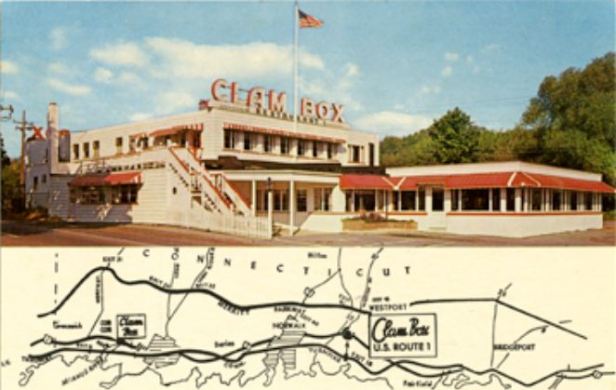By Emily Dunnack for Your Public Media
As the weather warms up, so does the lure of the open road and all that comes with it—scenic views, the ocean breeze along the coast, and everyone’s favorite: road food! While it may not be warm enough to go for a swim in Long Island Sound, it is perfect weather for a stop at one of the popular seafood restaurants that dot the Connecticut coast.
Seafood has been popular on the New England coast for as long as this land has been inhabited. Native Americans in what is now Connecticut harvested clams and oysters, and the colonists who came later also enjoyed these salt water treats. Seafood shacks began to pop up in the early part of the 20th century and continue to thrive today. The Clam Box, opened Memorial Day in 1939 as a small seafood stand on the Boston Post Road in Cos Cob. As it grew in popularity the restaurant expanded and opened two other locations—Westport and Wethersfield. The restaurants were favorites around the state until they closed in 1980.
Lobster Rolls and Clam Chowder with a Connecticut Accent
The lobster roll is a New England classic and though today we often think of Maine as lobster central, Connecticut waters have long been a source for the prized meat. We can thank Harry Perry, the owner of a Milford fish shop for first serving the now-classic hot-buttered lobster roll in 1934. The roll features hot lobster dressed with lemon and butter served on a grilled, split-top roll. Another Connecticut seafood specialty is clam chowder. Though sometimes called Rhode Island Chowder or Southern New England chowder, this style of chowder was often referred to as Connecticut clam chowder in early cookbooks and menus. Connecticut chowder distinguishes itself from creamy New England and tomato-based Manhattan styles with its salt pork and a water-based broth thickened with potato. Chowder purists claim this stripped-down version lets the true clam taste shine through.
Emily Dunnack is the Head of Education Programs at the Connecticut Historical Society.
© Connecticut Public Broadcasting Network and Connecticut Historical Society. All rights reserved. This article originally appeared on Your Public Media
Note: ConnecticutHistory.org does not edit content originally published on another platform and therefore does not update any instances of outdated content or language.









